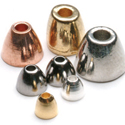
Hook: Daiichi 2546 or X452 #3/0-#6
Thread: MFC 6/0 or UTC 140 White
Tail: 6-8 neck or saddle hackles mixed with a complimentary color(s) of Crystal Flash
Body (Optional): Pearl or Silver Poly Braid
Wing/Collar: Bucktail, tied in 2 clumps along the sides of the hook
Top Wing: Bucktail
Topping (Optional): Peacock Herl
Throat: Red Crystal Flash or Flashabou
Eyes: Prism Tape Eyes
Tying Note: Vary the size and color of the pattern to suggest the local forage base, try tying bright attractor combinations such as red and yellow as alternative.
Travelling fly fishers or those preferring to target multiple species often inventory a broad basic selection of patterns. Adams, Wooly Buggers, and Gold Ribbed Hares Ears are examples of this approach. From a streamer perspective no fly box would be complete without a cross section of Lefty Kreh’s versatile Deceiver.
The Deceiver was conceived over 40 years ago by fly fishing icon Lefty Kreh for chasing Chesapeake Bay Striped Bass. This proven pattern offers a generic baitfish profile that adapts matches any forage, in both fresh and saltwater, from long slender needlefish to broad shiners. Deceivers track straight shed water in a heartbeat making them a breeze to cast.
Deceivers consist of two basic components, hackle tails and bucktail wings/collars. Tails consist of 6-8 neck or saddle hackles paired together in 2 bunches and tied in place on top of the hook shank. About 3-4 times the shank length is a good proportional basis. Depending upon tyer choice and the baitfish being imitated either neck or saddle hackles can be used. Saddle hackles are suited for long slender Deceivers; neck hackles offer a broader profile. Some contend thin stemmed saddle hackles provide better action. For enormous Deceivers try schlappen hackles. No matter the hackle choice the finished tail should have an even blade-like profile.
The challenge of creating a proper tail rests with hackle alignment. There are a few tricks available depending upon tyer preference. Select straight flat hackles that have similar profiles. To align the flies using a dry approach lay the hackle tips on your thigh convex to concave side so they flow together as one, 3-4 hackles per grouping. Use the forefinger to press and ally the tips. Pick up the 3-4 hackles by the base gently stroking them together completing the alignment process. Pinch the paired hackles between the thumb and forefinger so the tips flow back into the palm area the waste material protruding forward. Entire groups of hackles can be evened together as well by holding them at the base and rolling them between the thumb and forefinger. Another method involves dipping the hackle fibres tip first into a glass of water. Once soaked, stroke the hackles from butt to tip, evening them. This method works well and makes blending the two hackle groups a cinch. Experiment with these methods and choose one that works best. When tying in the tails avoid stripping the flue from the base as stripped stems often roll and twist. The remaining flue provides traction aiding the tie in and positioning process.
The best streamer bucktail comes from the top 2/3rds of the tail has a soft feel and a corrugated look. This top portion hair is solid, easy to manipulate and resists flaring. Select a clump appropriate to the size and mass of the Deceiver being created. Keep in mind, sparse clumps are easier to tie in and breather better. About the diameter of a pipe cleaner or half a pencil is ideal. Select and grasp a bucktail clump and stand it up 90 degrees to the hide to approximately align the tips. Trim the clump and remove the shorter fibres from the base. Reposition the grip so any long individual errant fibres can be removed from the tips. Avoid stacking, as natural somewhat ragged bucktail provides better light penetration to the fly.
Deceivers consist of 3 bucktail clumps. Two clumps of typically white bucktail are tied along the sides of the hook about ¼ of the shank back from the eye forming the collar. The third, often contrasting color, is tied in on the top. The belly of the fly is left clear offering an unobstructed view of the body and gills. The bucktail must extend back onto the hackle tails, 2 times the shank is ideal. Ensuring correct bucktail length augments the baitfish profile and more importantly prevents the tail from fouling around the hook. Pinch the prepared bucktail between the thumb and forefinger by the butts. Trim the protruding butt fibres on an acute angle creating a firm tie in. Adding a dab of brushable superglue to the trimmed butts prior to tie provides additional durability. Once the collar and wing is tied brush and flow the fibres together.






